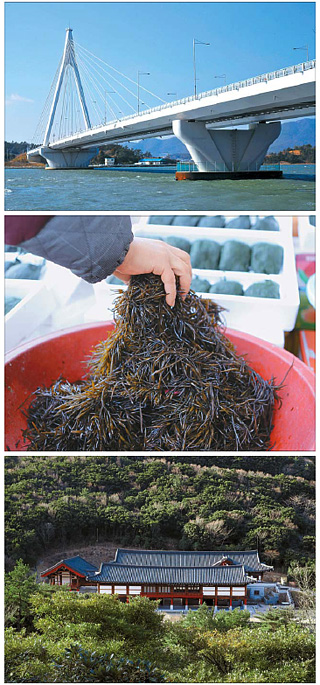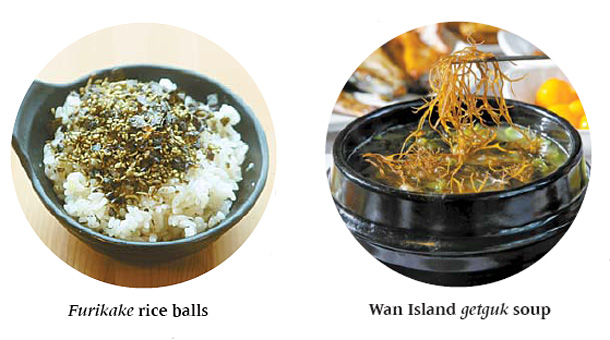Wan Island offers a lush escape to take a rest : A weekend trip to the South Jeolla hideaway offers unique delights

The hiking trails of the Wan Island arboretum provide a scenic view of the colorful forest. [LIM HYUN-DONG]
The evergreen oak trees (Quercus acuta) are the island’s treasure. Since people began inhabiting the island, its trees have been used to assist in building houses and farming. The wood of the oak trees is not only stronger than pine trees, but are also resistant to decay from sea water. In the past, hungry islanders used to sell the trees at the marketplace, which sold for enough to sustain their families. The trees can only be found in two areas of the country, one of which is on Wan Island. A mountain takes up 60 percent of the island, and two thirds of that is made up of the Wan Island arboretum.
Walking into the forest is like experiencing a breath of fresh air. Of the 12 major tree species in Korea, the evergreen oak has the highest carbon absorption rate. Eliminating carbon dioxide and carbon monoxide, the trees provide a healthy dose of oxygen to the forest. The arboretum also hosts camphor trees, whose leaves are used for aromatic medicine and insect repellents. Living alongside these trees is a large variety of wildlife that populate the mountain.

Top: The water beneath the bridge to Wan Island is crystal clear. Middle: The marketplace on Wan Island offers sea produce gathered by locals. Bottom: The Sanlim Museum is a welcome rest stop for visitors hiking the forest. [LIM HYUN-DONG]
There are two trains that leave from Seoul on the KTX railroad before 6 a.m. Leaving at the wee hours of the morning would reward weary travellers with a filling breakfast upon arriving at Mokpo station, such as its famous nakji yeonpotang or octopus soup. Upon arrival, renting a car from the station is a recommended idea for travel around the island. The rental car service ranges from 80,000 to 120,000 won ($70-105) for 36 hours in a small car. The KTX also provides a 25 percent discount on tickets for trains that leave before 6 a.m.
Traveling to the island in a personal car is not recommended as the travel time is approximately six hours if there is no traffic, with only one rest stop - which may ruin the trip for weary visitors. Additionally, tolls for the round trip add up to around 50,000 won.
9 a.m. - From Mokpo to Haenam county
Though the quickest route recommended by most navigation services will be by taking the highway, going by the 806 local road towards the Haenam peninsula will allow the best view of the farmlands. Decorated with ripe cabbage, the green farmlands are a scenic preview of the views seen on the island. The Korea Tourism Organization has recommended this peninsula as a vacation spot worth visiting this month as well.
10 a.m. - The marketplace
The Namchang market in Haenam is one of few existing marketplaces in the countryside that continue to see an increasing number of visitors. Townspeople from nearby Bukpyeong bring local food and produce, as well as a large assortment of seafood such as fresh squid.
Elsewhere, the Wan Island central market is open for business every day of the week. Sea items like gamtae, maesaengi, and hijiki are particularly popular during this season. These are popular ingredients used to make variations of rice such as the bean sprout hijiki rice. A handful of maesaengi costs 3,000 won and hijiki costs 5,000 won at the Wan Island jungang market.
11 a.m. - Wan Island arboretum
The forest trail leading up to the famous arboretum is 50 kilometers (31 miles) and is often used by locals as a hiking trail. The path is a relatively accessible course for visitors of all ages. The recommended path visits the Sanlim Museum tucked away inside the forest. Taking the swiveling trail up toward the wooden deck 600 meters (656 yards) into the path allows visitors to have the feeling of walking through the clouds, especially on foggy days. The round trip to the museum takes about 5,000 steps and is approximately 3 km long.
2 p.m. - Lunchtime
Sea Filled Noodles is a restaurant that specializes in just that - seafood noodle dishes. The restaurant waits at a convenient location for hikers exiting the hiking trail. The restaurant’s interior is nicely lit due to its large glass windows, which also give diners a spacious view of the outdoors. Hijiki, kelp, and seaweed are used as ingredients for the noodle base, which are then hand-shaped into noodles in its kitchen. The dishes consist of items such as cream pasta with abalone, mulhoe or raw fish soup with abalone, janchi guksu or thin noodles in broth with vegetables, and most notably, their specialty furikake rice balls. Their furikake mix is made of laver, kelp, stir-fried anchovies, and sesame seeds. The rice balls are sold for 1,000 won apiece and are a great complement to the noodle dishes.
6 p.m. - Seafloor seawater sauna
It would be an understatement to say taking a dip in the seawater baths is relaxing. The clever construction of the baths allows visitors to see the outside waves crashing against the windows as much of the bathhouse is located inside the sea. Unfortunately, this luxury is only available for the male baths as the women’s baths are located one floor above. Travelers wishing to visit the sauna will need to go to the Wando Hotel. The sauna is open only from 5 to 7 p.m.
10 p.m. - Stargazing in the arboretum
“There are an incredible amount of stars,” said O Deuk-sil, the 47-year old director of the Wan Island arboretum. “It’s common to see shooting stars here.”
Mount Obong acts as a wall that blocks any light from protruding in, which makes the forest a fantastic location for stargazing. Outside noise disappears at night as well, and the forest becomes silent enough to hear footsteps from wildlife living in the area. The recommended location in the forest for stargazing is at the walking trail near the lake.

Sunday 7 a.m. - Morning walk
The mountain is foggy in the morning due to the nearby lake and valleys, and walking between the peaks of Sanghwangbong and Beakunbong gives hikers the magical feeling of walking through the clouds. Adventurers may travel even farther up to the second observatory to be able to see the sunrise from far behind the distant Gogeum Island in the south.
1 p.m. - Tasting a rare delicacy
Taking plant life growing on rocks on the seashore and adding it as an ingredient to doenjangguk has been a culinary tradition unique to Wan Island. Referred to as getguk, this mishmash of various plants was eaten by hungry islanders in the past and was appropriately given the name “sea plant.” However, these plants are increasingly hard to find so even locals rarely get to enjoy this dish. Kim Suk-hui, the 57-year old restaurant owner of Binggeurae Sikdang referred to it as the “dish before disappearing.” Of all the restaurants on the island, there are only two that offers this rare food, some of which even describe it as the perfect hangover cure.
3 p.m. - Returning to Haenam
The view from atop the hiking trail of the Wan Island arboretum provides a striking scene of the mountain range of Haenam. Driving back across the bridge, visitors can take a visit to the peaks of Mount Dalma, which goes as high as 638m at the peak of Gogyebong. Standing atop the cable car tower located at this peak rewards hikers with yet another view of the lush green mountain. Visitors may also take a look around Mihwang Temple, which is highly recommended for those looking to do a temple stay.
Recommended lodging
The Wando Pension located near the arboretum is the perfect spot for those looking for early morning hikes and late-night stargazing. There are additional options as well nearby the forest, including Swaeiri Pension, Sol Beach Pension, Garden of Heaven Pension, and the Oneness Resort.
BY KIM YOUNG-JU [chung.jinhong@joongang.co.kr]










with the Korea JoongAng Daily
To write comments, please log in to one of the accounts.
Standards Board Policy (0/250자)